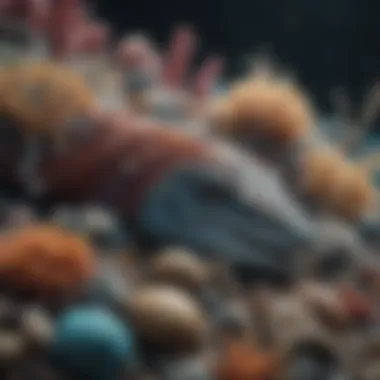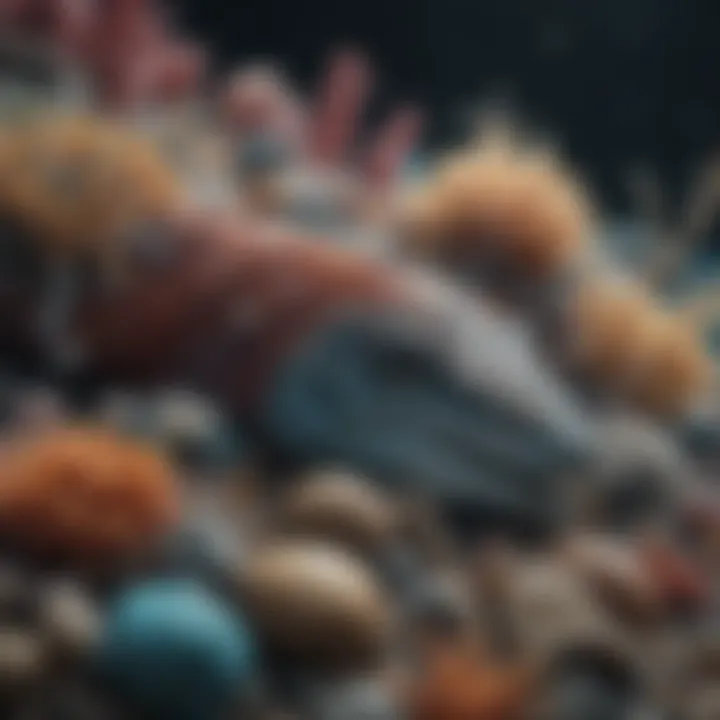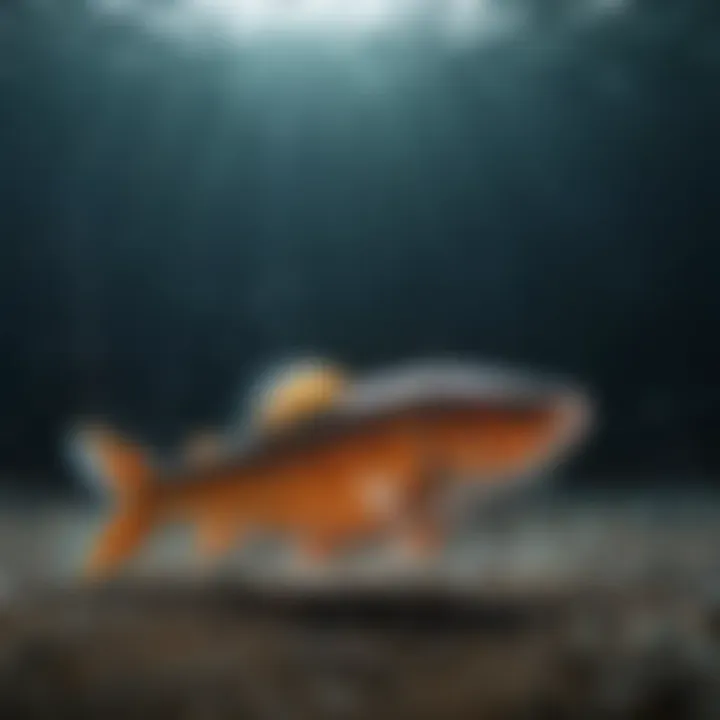Exploring the Effects of Microplastics on Wildlife


Intro
The issue of microplastics has emerged as a critical concern in environmental science, particularly regarding its impacts on animal life. Microplastics are tiny plastic particles, often smaller than five millimeters, which arise from the breakdown of larger plastic waste or are manufactured for specific purposes. Their widespread presence in marine and terrestrial ecosystems raises urgent questions about how these substances interact with various forms of wildlife.
As these microplastic particles infiltrate habitats, they pose a significant threat not only to individual species but also to entire ecosystems. The ingestion of microplastics can trigger physiological distress, disrupt food chains, and ultimately influence biodiversity. Consequently, understanding the pathways through which microplastics enter the bodies of animals and the implications of such exposure is imperative for effective conservation and policy-making efforts.
This article will explore several key facets of this issue, including:
- The mechanisms through which microplastics enter different animal species.
- The physiological responses observed in various organisms as a result of microplastic exposure.
- Specific case studies showcasing the impact of microplastics on wildlife.
- The broader ecological consequences of microplastic pollution.
- The need for further research and heightened awareness of this pressing environmental issue.
By delving into these areas, we can begin to unravel the complex relationships between microplastics and animal life, paving the way for informed actions to mitigate these impacts.
Prelude to Microplastics
Microplastics have emerged as a substantial environmental concern, recognized for their pervasive presence in various ecosystems. Understanding microplastics is crucial due to their impact on animal life and biodiversity. This understanding guides effective response strategies and raises awareness about pollution. Addressing this issue involves dissecting the nature of microplastics, their sources, and the specific mechanisms through which they affect wildlife.
Definition and Types of Microplastics
Microplastics are plastic particles smaller than five millimeters in diameter. They can be categorized into two main types: primary and secondary microplastics. Primary microplastics are manufactured at this size and often used in products like cosmetics and industrial abrasives. Secondary microplastics, on the other hand, are fragments that result from the degradation of larger plastic items over time.
The types of microplastics also include fibers from textiles and nurdles, small plastic pellets used in manufacturing. Understanding these definitions is essential for grasping the various ecological dynamics in which microplastics are involved.
Sources of Microplastic Pollution
Microplastics arise from multiple sources, and their entry into ecosystems is concerning. Common sources include:
- Industrial Processes: Factories often release small plastic particles as waste.
- Consumer Products: Products like personal care items, which contain microbeads, contribute significantly.
- Degrading Larger Plastics: As plastic items break down, they form microplastics, posing risks to wildlife.
- Sewage Treatment: Wastewater contains microplastics from laundry and other domestic sources, often not fully removed during treatment.
These sources highlight how deeply embedded microplastics are in our everyday life, signaling an urgent need for action to mitigate their impact on animal health and ecological balance.
Microplastics in Marine Environments
Microplastics are increasingly relevant in discussions about marine health. The oceans cover over 70% of the Earth, making them a significant repository for environmental pollutants, including microplastics. Due to their small size, microplastics can easily enter marine ecosystems, impacting both wildlife and food chains that are crucial to human nutrition as well.
The presence of microplastics in marine environments is alarming. They originate from various sources like plastic waste, degraded plastic products, and even synthetic fibers from clothing. As tides and currents distribute these particles across vast areas, their concentration can vary greatly, leading to certain hotspots where marine life is particularly at risk. Understanding the distribution and impacts of microplastics is vital for formulating effective strategies to address their negative effects on oceanic ecosystems.
Distribution and Concentration in Oceans
Microplastics are found throughout almost every marine environment. Research shows that major plastic accumulation zones exist in ocean gyres, areas where currents converge and trap debris. For example, the Great Pacific Garbage Patch is a significant location where plastic waste accumulates, resulting in a high concentration of microplastics.
These particles range in size from 1 micrometer to 5 millimeters, which is small enough to be ingested by a variety of marine organisms. The notion that microplastics are dispersed not just on the surface but also throughout varying depths of ocean water raises concerns about their long-term ecological implications.
Impacts on Marine Species
The consequences of microplastics on marine life encompass various aspects, affecting creatures across different levels of the food chain. Understanding these effects is crucial for assessing the overall health of marine ecosystems.
Filter-Feeding Organisms
Filter-feeding organisms, such as mussels and oysters, play a critical role in marine ecosystems. They filter large volumes of water for food, which includes plankton and other small particles. Unfortunately, their feeding habits make them an easy target for microplastic ingestion.
Their unique feeding mechanism allows them to collect microplastics unintentionally. This not only affects their health but also enables microplastics to move up the food chain as these organisms are consumed by larger animals. Thus, the vulnerability of filter-feeders highlights their significance in the broader context of marine pollution.
Predatory Fish


Predatory fish, including species like tuna and swordfish, serve as key indicators of oceanic health. They occupy higher trophic levels and consequently face greater exposure to microplastics. When predatory fish consume smaller fish that have ingested microplastics, toxins can accumulate within their bodies.
This bioaccumulation can lead to significant health problems, including reproductive issues and impaired growth. The presence of microplastics in predatory species raises concerns about food safety for humans as well, given that these fish make up a substantial part of the global seafood market.
Marine Mammals
Marine mammals, like dolphins and seals, also face threats from microplastics. These animals are top predators and thus are more likely to be affected by the toxins released from ingested microplastics. Their aspects of social structure and behavior can be disrupted due to exposure. For instance, impaired hunting abilities can result from poor health stemming from microplastic ingestion.
Microplastics in Freshwater Systems
The presence of microplastics in freshwater systems is a significant issue. Freshwater ecosystems, including rivers and lakes, are vital for biodiversity and human consumption. The introduction of microplastics into these environments has raised concerns regarding their impact on freshwater species and overall ecosystem health. Microplastics can affect not only aquatic life but also potentially compromise human health through drinking water contamination and food sources.
Sources and Distribution in Rivers and Lakes
Microplastics originate from various sources, such as urban runoff, wastewater discharge, and agricultural practices. These tiny plastic particles can accumulate in freshwater bodies through direct entry and atmospheric deposition. Once in the water, microplastics can become easily distributed, with current indicating their presence across different areas. Research indicates that rivers often act as transport pathways, moving microplastics from urban areas into larger bodies of water.
Moreover, the size and shape of microplastics vary, influencing their transport and accumulation in sediment layers. Some studies have shown a higher concentration of microplastics in sediment compared to the water column, indicating potential long-term effects on benthic organisms.
Effects on Freshwater Fauna
Amphibians
Amphibians are crucial for monitoring freshwater ecosystem health as they play a significant role in nutrient cycling and serve as indicators of environmental changes. Their permeable skin makes them particularly susceptible to microplastics. Ingestion of these particles can disrupt their breeding patterns and affect overall survival rates. The delicate life cycle of amphibians, which includes both aquatic and terrestrial phases, makes them vulnerable to microplastic exposure across different environments.
Advantages of focusing on amphibians include their ecological importance and sensitivity, which can provide insightful data on the overall impact of microplastics in freshwater, enhancing our understanding of these pollutants.
Invertebrates
Invertebrates form the backbone of the food web in freshwater systems. These organisms, ranging from mollusks to crustaceans, acquire microplastics by filtering water or through direct contact. The ingestion can lead to physical blockages, reduced feeding efficiency, and exposure to harmful chemicals attached to the particles. The significance of invertebrates lies in their role as food sources for larger species, making their health vital for maintaining ecological balance.
The unique aspect of invertebrates is the diversity of species affected and the potential cascading effects on the entire ecosystem. Understanding how microplastics influence invertebrate populations can provide insights into broader ecological ramifications.
Fish Species
Fish species, often at the top of the food chain, are greatly influenced by microplastic pollution. They may ingest microplastics directly from their environment or indirectly through prey. The presence of these particles can lead to various physiological issues, including inflammation and reproductive problems. Fish that consume microplastics could also pose health risks to humans who consume them.
The particular concern with fish species is their economic and nutritional importance. Studying how microplastics affect fish can inform both environmental policies and public health guidelines, making them a focal point in discussions about aquatic pollution.
Microplastics in freshwater systems not only hinder the health of the organisms within them but also pose challenges to ecosystem stability and human health.
Entry Pathways of Microplastics into Animal Bodies
Understanding how microplastics enter animal bodies is essential in evaluating their impact on ecological systems. These pathways can lead to a range of physiological effects, influencing not only individual organisms but also entire populations. Recognizing these routes helps in addressing the larger issue of microplastic pollution and developing strategies to mitigate its harmful effects.
Ingestion Through Food Sources
Ingestion is one of the primary means through which microplastics enter animal bodies. Many marine and freshwater species consume food that contains microplastics, unknowingly. This might occur as prey items for filter feeders like mussels, which absorb water along with particulate food. As these organisms filter large volumes of water, microplastics get trapped in their bodies.
Fish are also affected. They often ingest microplastics along with their usual diet, such as smaller marine life. This phenomenon raises concerns regarding bioaccumulation. When higher trophic level organisms consume lower ones that contain microplastics, these tiny particles can move up the food chain. As a result, predators may end up with higher concentrations of microplastics, potentially affecting their health.
Additionally, the presence of microplastics in ocean and river sediments makes it easier for bottom-dwelling fauna, like benthic invertebrates, to ingest these particles. Overall, ingestion through food sources is a significant route of entry, which can lead to detrimental effects on various species.
Absorption Through Skin and Gills
Apart from ingestion, animals can also absorb microplastics through their skin or gills, especially in aquatic settings. For many fish, gills are crucial for respiration, acting as fetures for extracting oxygen from water. However, they also serve as an entry point for microplastics. Small particles can penetrate the gill membranes, leading to potential internal health issues. This is particularly relevant for species exposed to polluted waters where microplastics are prevalent.


Amphibians present an added layer of complexity. Their dual life, existing both in water and on land, means they face unique exposure risks. Skin absorption is critical for amphibians, which can encounter microplastics in wet environments. It raises concerns for species diversity, as some might be more vulnerable than others.
Physiological Effects of Microplastics on Animals
Understanding the physiological effects of microplastics on animal life is crucial for assessing their overall impact on ecosystems. These effects can manifest in various forms, significantly altering the health and behavior of impacted species. Microplastics can disrupt normal biological functions, which raises concerns for biodiversity and ecosystem stability. By examining specific physiological changes, researchers can gain insight into how microplastics threaten wildlife and ultimately human health.
Toxicological Impacts
Chemical Additives from Microplastics
Microplastics often contain a range of chemical additives that enhance their properties. These additives can include plasticizers, flame retardants, and colorants. The presence of these substances can contribute to significant toxicological impacts on animal health. One key characteristic of these additives is their ability to leach into the surrounding environment, which can result in contamination of the food chain. This not only affects the organisms directly consuming microplastics but also has implications for species higher up the food chain.
The unique feature of these additives is their potential to bioaccumulate and biomagnify. Their small size allows for easy ingestion by smaller organisms, which can then be consumed by larger predators. This chain reaction can lead to higher concentrations of toxic substances in top predators, creating risks for entire ecosystems.
One disadvantage worth noting is the variability in how different species react to these chemical additives. While some species may show a high tolerance, others may experience severe health repercussions, complicating the assessment of risk for biodiversity.
Heavy Metal Contamination
Heavy metals can also be found in association with microplastics in various environments. This contamination occurs when microplastics adsorb metals from their surroundings, leading to an increased concentration of harmful substances. Heavy metal contamination poses a serious threat to animal life because these metals can have detrimental physiological effects. For example, lead and mercury can impair neurological functions, disrupt endocrine systems, and even result in reproductive failures.
The unique aspect here is that heavy metals do not degrade; they persist in the environment and accumulate over time. This characteristic makes heavy metal contamination particularly concerning, as it leads to increased exposure for animals within that ecosystem.
One notable benefit of raising awareness about heavy metal contamination is the potential for remediation strategies. Understanding the pathways through which microplastics and heavy metals interact can drive future research and policy changes aimed at mitigating their impact on wildlife.
Effects on Growth and Reproduction
Microplastics have been shown to influence growth and reproductive success in numerous species. Their presence can lead to reduced growth rates, smaller sizes, and altered reproductive outputs. For some fish species, studies indicate that exposure to microplastics can result in lower fecundity and greater egg mortality rates. In amphibians, larval development can be adversely affected by microplastic ingestion, leading to developmental delays or malformations.
Overall, the physiological effects of microplastics present a complex challenge for animal life. These impacts influence not just individual organisms but can ripple through entire populations and ecosystems, highlighting the urgent need for further research in this compelling field.
Behavioral Changes Induced by Microplastics
The influence of microplastics on animal behavior is a critical area of study. This section highlights how microplastics may affect various behavioral aspects of different species, potentially disrupting ecological interactions. As microplastics pollution rises, understanding these behavioral changes can provide insight into the health of ecosystems and the sustainability of biodiversity.
Altered Feeding Habits
Microplastics can lead to significant alterations in feeding behavior among animals. Many aquatic species, especially filter feeders, ingest microplastics while consuming food. This inadvertent consumption can change their dietary preferences and, more importantly, their nutritional health. For instance, certain fish species may avoid areas with high microplastic concentrations. This aversion is likely a response to detecting compromised food sources or degraded habitats.
Notably, the presence of microplastics can disturb the balance of available prey. If one species significantly reduces its feeding in certain areas, it can lead to an unintended increase in other organisms. Consequently, this can create an imbalance in the ecosystem, affecting the structure of food webs.
Some studies indicate that changes in feeding habits associated with microplastics can lead to reduced growth rates and overall health in affected species. When animals consume microplastics, they may consume fewer nutrients, disrupting energy resources essential for vital biological processes.
Predator-Prey Interactions
Microplastics also have implications for predator-prey dynamics within ecosystems. For some predators, the presence of microplastics can make prey less detectable. For example, specific fish may mistake microplastics for their natural prey items. The ingestion of these materials leads to decreased predation efficiency.
Furthermore, as some predators alter their hunting strategies to cope with reduced prey availability, the dynamic of interactions shifts. This adjustment can lead to increased competition among predators. If certain species adapt better than others, it may shift the hierarchies and balances in these populations.
The long-term consequences can be detrimental to biodiversity. As predator-prey relationships become strained, the survival of species could be at risk, affecting overall ecosystem health. Given these factors, the study of behavioral changes induced by microplastics serves as an essential component in understanding ecological dynamics.
“The impact of microplastics is not just on physiology but also significantly influences the behavioral patterns of various species, altering the intricate relationships woven into ecosystems.”
Overall, the behavioral modifications caused by microplastics underscore the urgent need for more research into their impacts, especially as ecosystems face multiple stressors. This understanding can inform future regulatory policies and conservation efforts.


Microplastics and Biodiversity
Microplastics pose a significant threat to biodiversity, affecting various aspects of animal life and the ecosystems they inhabit. The wide distribution of microplastics in both marine and freshwater environments leads to complex interactions with wildlife. These interactions can cascade through the food web, affecting not just individual species but entire ecosystems. Understanding the impact of microplastics on biodiversity is crucial for developing strategies to mitigate environmental damage and protect vulnerable species.
Threats to Species Survival
Microplastics endanger the survival of numerous species across different habitats. For instance, small aquatic organisms, such as zooplankton, are particularly susceptible to ingestion. When these organisms consume microplastics, they can suffer from reduced reproductive success and increased mortality rates. Filter-feeders like mollusks accumulate microplastics, leading to their potential decline.
Moreover, larger species are also affected. Predatory fish, which may consume smaller fish that have ingested microplastics, also absorb these pollutants. The accumulation magnifies the danger that microplastics pose to various trophic levels. Consequently, this can initiate a drastic reduction in populations, disrupting food chains and ultimately leading to species extinction.
Ecosystem Health and Resilience
The health of ecosystems is increasingly compromised due to microplastic pollution. Ecosystem resilience refers to an ecosystem's ability to recover after disturbances. Microplastics hinder this resilience by degrading habitat quality, altering species interactions, and undermining key ecological functions.
For example, plastic debris in marine environments can smother coral reefs. These reefs serve as vital habitats for numerous marine species. When corals are stressed due to microplastic contamination, it can lead to reef degradation and loss of biodiversity. Similarly, freshwater ecosystems like lakes and rivers face challenges as microplastics disrupt the balance.
To restore ecological balance, it is essential to address microplastic pollution. Strategies may include regulating plastic production, enhancing waste management systems, and promoting community awareness about plastic usage.
"Microplastic pollution threatens not only marine life but fundamentally undermines ecosystem integrity worldwide."
Policy Implications and Solutions
Microplastics present significant challenges at both ecological and policy levels. Effective policy frameworks are essential to address the multifaceted issues arising from microplastic pollution. Governmental and non-governmental approaches must prioritize understanding the implications of these materials not just for animal life but also for human health and ecosystems. Solutions must combine regulatory measures, research, and public engagement to mitigate risks associated with microplastics. This section aims to explore current regulatory frameworks and suggest future pathways for policy and advocacy.
Current Regulatory Frameworks
The regulation of microplastics varies across regions, reflecting diverse environmental policies and awareness levels. Some countries have instituted specific bans on microplastics in cosmetic products. The European Union, for instance, has made strides by instituting the Plastic Waste Directive focusing on single-use plastics and microbeads. In the United States, the Microbead-Free Waters Act is another example, designed to limit microplastic use in personal care products.
While the existing framework has made some positive impacts, it often lacks inclusivity regarding broader sources of microplastics. Programs aimed at educating public on microplastic pollution remain fragmented and underfunded, hindering effective implementation of existing regulations.
"Current frameworks addressing microplastics still require improvements to adequately protect wildlife and ecosystems."
Future Directions for Policy and Advocacy
To tackle microplastic pollution comprehensively, future policy must emphasize prevention and education. Governments should develop measures that cover all sources of microplastics, including textiles and industrial waste. Emphasizing research-driven policies can aid in understanding the extent of microplastics’ impacts, enabling informed decisions about mitigation.
Stronger collaborations between the public and private sectors could also lead to innovative solutions. Initiatives like clean-up projects in aquatic environments can aid awareness and strengthen community engagement.
Advocacy must also play a role in pushing for tighter regulations. Ecosystem organizations can mobilize public opinion in favor of stricter standards and transparency in plastic production and waste management processes. By creating alliances among various stakeholders—scientists, policymakers, and citizens—strategies to reduce microplastics' prevalence could gain momentum.
Ending
The examination of microplastics and their impact on animal life draws attention to a significant environmental issue that necessitates urgent consideration. As microplastics infiltrate various habitats, their consequences extend beyond individual species, influencing entire ecosystems. Understanding the implications of this contamination helps in assessing the full spectrum of risks that it poses to biodiversity and human health.
Microplastics create a pathway for toxins to enter the food chain, thereby complicating the ecological balance. Filter-feeding organisms, for instance, may ingest these particles, which then pass on up the food chain. This phenomenon raises alarming questions regarding the health of larger predators and ultimately affects humans who rely on these animals for nourishment. Thus, the ramifications are not just confined to wildlife but echo through to human systems and economies.
Furthermore, recognizing the ecological relationships disturbed by microplastic pollution is crucial for developing effective policy frameworks. By understanding the intricate details of how microplastics disrupt animal life, stakeholders can advocate for better practices, reducing plastic production and enhancing clean-up efforts.
Summary of Key Findings
- Microplastics are pervasive: They are found in oceans, freshwater systems, and terrestrial environments, entering wildlife through various pathways such as ingestion or absorption.
- Health impact on animals: These tiny particles can cause toxicological effects and affect growth, reproduction, and behavior in diverse species, including amphibians, fish, and marine mammals.
- Implications for ecosystems: The disturbance of predator-prey dynamics due to microplastics can lead to reduced biodiversity and ecosystem health, potentially provoking long-term ecological shifts.
"The interplay of microplastics with wildlife ecosystems is a complex issue that requires immediate and sustained intervention."
Call for Further Research
Further research is essential to fully understand the long-term effects of microplastics on animal life. Key areas for investigation include:
- Mechanisms of absorption and toxicity: More studies should explore how different species absorb microplastics and the compound effects on physiology and behavior.
- Impact assessment: Comprehensive assessments of various habitats can help identify vulnerable species and ecosystems at risk due to microplastic pollution.
- Innovative solutions: Research into biodegradable alternatives and advanced material recovery techniques can lead to viable strategies to minimize microplastic contamination.
Continued research efforts will also sharpen our knowledge on regulatory impacts, ultimately bridging the gap between science and policy. Increasing public awareness through educational initiatives can complement these research efforts, ensuring that addressing microplastics remains a priority on environmental agendas.







